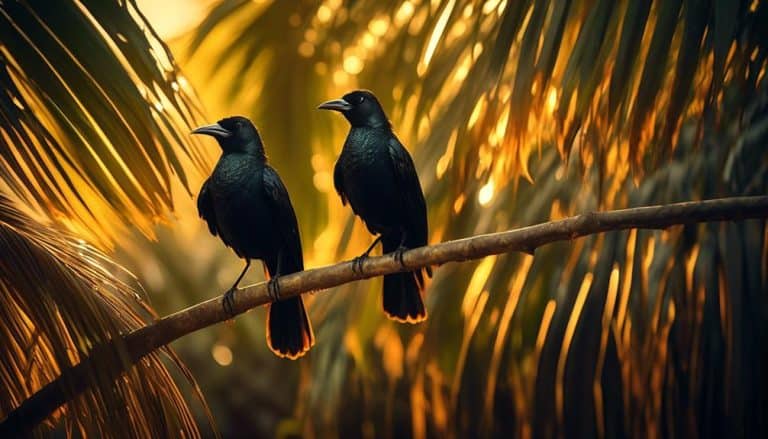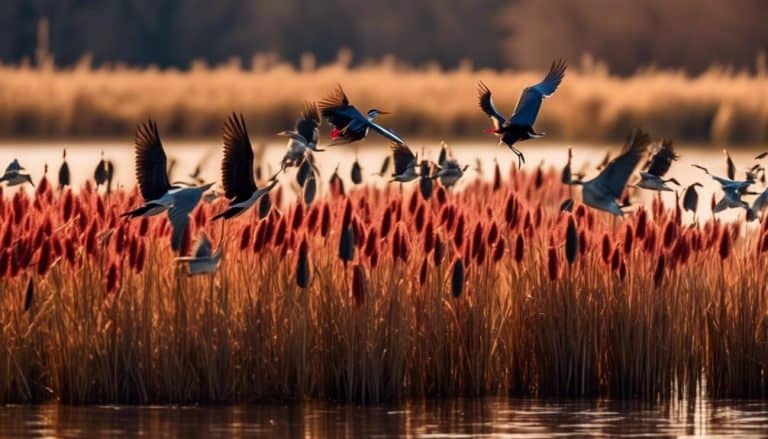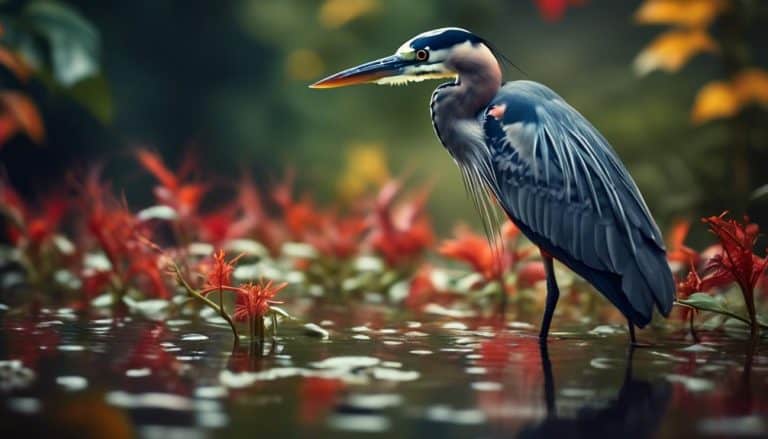As I walk along the shores of Long Island, I am constantly surrounded by a symphony of fluttering wings and melodic chirps, a vibrant tapestry woven by the common birds that call this place home. From the graceful hawks soaring high above, to the delicate warblers hiding amongst the foliage, the diversity of avian life on this island is truly awe-inspiring.
But what are these common birds that grace our skies and fill our landscapes? Join me on this exploration, as we uncover the fascinating world of Long Island's feathered residents and unravel the mysteries that lie within their wings.
Hawks and Falcons
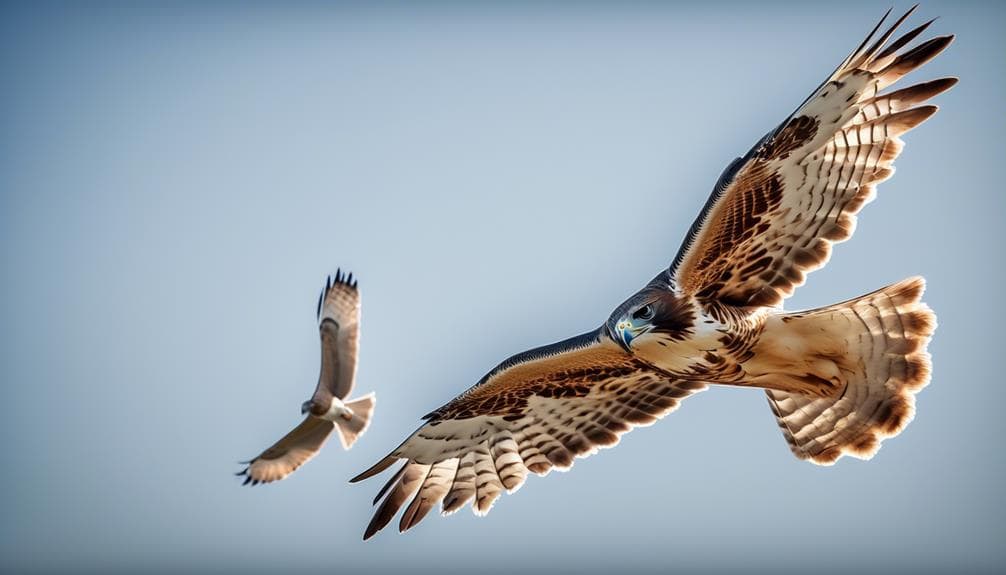
What are the distinguishing characteristics of hawks and falcons found on Long Island?
Hawks and falcons are both raptors, but they've distinct characteristics that set them apart. Hawks are known for their broad wings and long tails, while falcons have pointed wings and shorter tails. These physical differences reflect their hunting behaviors and nesting habits.
Hawks are skilled hunters that rely on their keen eyesight to spot prey from great heights. Once they've located their target, they swoop down with incredible speed and agility. Their powerful talons and sharp beak enable them to capture and kill their prey swiftly. Hawks are known to build large nests made of twigs and branches in tall trees, where they raise their young.
Falcons, on the other hand, are renowned for their exceptional speed and aerial acrobatics. They're built for speed, with streamlined bodies and pointed wings that allow them to reach incredible speeds during their hunting dives. Falcons primarily feed on birds, which they catch mid-flight with their sharp talons. Unlike hawks, falcons nest in cliffs and other high locations, where they create simple scrape nests.
Understanding the distinguishing characteristics, hunting behaviors, and nesting habits of hawks and falcons on Long Island can provide valuable insights into these magnificent birds' lives and help in their conservation efforts.
Shorebirds and Waders

Shorebirds and waders found on Long Island exhibit a diverse range of adaptations and behaviors that allow them to thrive in their coastal habitats. These fascinating birds are known for their unique migration patterns and nesting habits.
Here are some interesting facts about them:
- Migration patterns:
- Many shorebirds and waders found on Long Island undertake remarkable long-distance migrations, traveling thousands of miles each year. For example, the Red Knot, a medium-sized shorebird, journeys all the way from the Arctic to South America.
- These birds rely on a combination of instinct and environmental cues to navigate their way across vast distances. They're equipped with keen senses and the ability to detect subtle changes in the Earth's magnetic field, which helps them stay on course.
- Nesting habits:
- Shorebirds and waders have diverse nesting habits. Some species, like the American Oystercatcher, build their nests directly on sandy beaches or rocky shores. These nests are simple scrapes in the sand or small depressions in the rocks.
- Other species, such as the Black Skimmer, nest in colonies, forming tightly packed communities on sandy beaches or marshy areas. These birds lay their eggs on the ground, and both parents take turns incubating them.
- Many shorebirds and waders are highly territorial during the nesting season, fiercely defending their nesting sites from intruders or predators.
Songbirds and Warblers
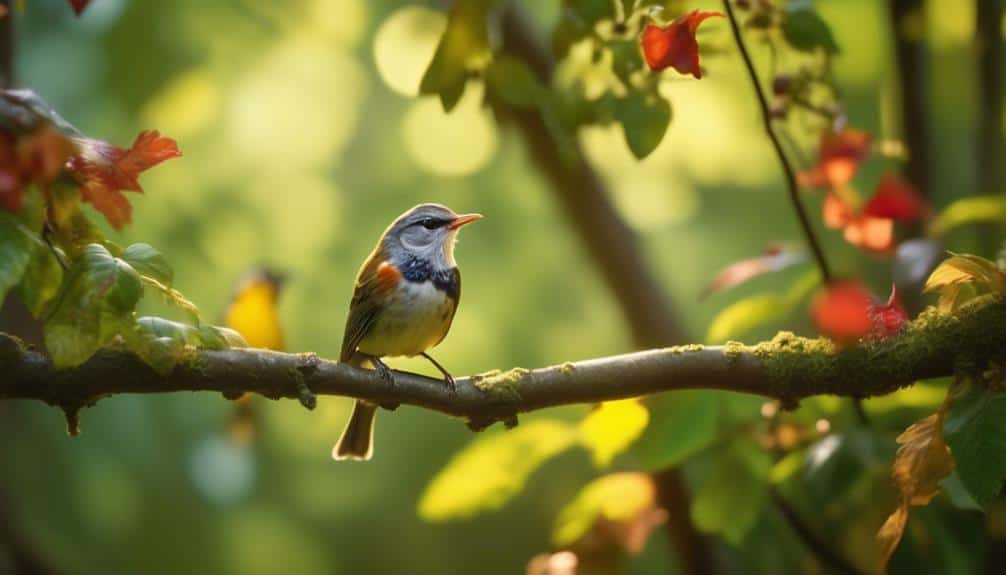
As we shift our focus to the fascinating world of songbirds and warblers, it's important to note their distinct characteristics and behaviors that set them apart from the shorebirds and waders we previously explored. Songbirds and warblers are a diverse group of small passerine birds known for their melodious songs and vibrant plumage. These birds are highly migratory, with many species undertaking long-distance journeys twice a year. Their migration patterns are influenced by the availability of food and favorable weather conditions.
On Long Island, there are several birdwatching hotspots where one can observe these beautiful creatures in their natural habitat. One such location is the Montauk Point State Park, situated at the easternmost tip of the island. This park serves as a major stopover for migrating songbirds and warblers, providing an excellent opportunity to witness a variety of species. Another popular destination is the Jamaica Bay Wildlife Refuge, located in Queens. This urban oasis is a haven for both resident and migratory birds, including numerous songbirds and warblers.
When embarking on a birdwatching adventure to observe songbirds and warblers, it's crucial to bring along binoculars, a field guide, and a keen eye for detail. By carefully observing their behaviors and listening to their distinctive songs, one can truly appreciate the beauty and complexity of these captivating creatures.
Waterfowl and Ducks

Waterfowl and ducks are a diverse group of aquatic birds known for their unique adaptations and behaviors in various wetland habitats. These fascinating creatures have captured the attention of birdwatchers and nature enthusiasts alike.
Here are some interesting facts about waterfowl and ducks:
- Duck migration patterns:
- Ducks, like many other bird species, undertake long and arduous migration journeys to find suitable breeding and feeding grounds.
- Some waterfowl species, such as the Mallard and the Black Duck, migrate south during the winter months to escape harsh weather conditions.
- Other ducks, like the Northern Pintail and the Blue-winged Teal, undertake impressive transcontinental migrations, traveling thousands of miles each year.
- Identification tips for different waterfowl species:
- Waterfowl species can be identified by their unique physical characteristics. For example, the Wood Duck stands out with its vibrant plumage and distinctive crested head.
- Pay attention to the shape and size of the bill, as it can vary among species. The long and slender bill of the American Wigeon sets it apart from other ducks.
- Observe the behavior and habitat preferences of the ducks. The Bufflehead, for instance, is often found diving for food in freshwater ponds and lakes.
- Marvel at their diverse adaptations:
- Waterfowl have evolved specialized adaptations to thrive in aquatic environments. Their webbed feet enable efficient swimming and diving.
- The waterproof feathers of ducks keep them dry and buoyant in the water. The oil glands near their tails produce an oily substance that coats their feathers, providing insulation and preventing water from seeping through.
With their impressive migration patterns and unique characteristics, waterfowl and ducks continue to captivate us with their beauty and resilience.
Raptors and Owls

Raptors and owls, with their impressive hunting skills and fascinating nocturnal adaptations, are a captivating group of birds found on Long Island. Raptors, such as hawks and falcons, are known for their keen eyesight, powerful talons, and hooked beaks that enable them to catch and kill their prey. Owls, on the other hand, have specialized feathers that allow them to fly silently, making them excellent nocturnal hunters.
Raptor conservation is an important aspect of bird conservation on Long Island. Many raptor species are facing threats such as habitat loss and degradation, pesticide poisoning, and collisions with vehicles and buildings. Conservation efforts focus on protecting and restoring their habitat, reducing the use of harmful pesticides, and raising awareness among the public about the importance of raptor conservation.
Owls have specific habitat requirements, and Long Island offers a variety of suitable habitats for them. They can be found in forests, woodlands, and open areas with a mix of trees and grasslands. Owls rely on these habitats for nesting, roosting, and hunting. They require large trees for nesting and undisturbed areas for hunting.
Understanding and protecting the habitats of raptors and owls is crucial for their survival on Long Island. By conserving their habitats and raising awareness about the importance of raptor conservation, we can ensure that these captivating birds continue to thrive in our area.
Frequently Asked Questions
What Are the Key Differences Between Hawks and Falcons in Terms of Physical Appearance and Hunting Behavior?
Hawks and falcons differ in physical appearance and hunting behavior. Hawks have broad wings and a larger size, while falcons have pointed wings and are smaller. Hawks soar and hunt from perches, while falcons dive and chase prey in mid-air.
Are There Any Specific Species of Shorebirds and Waders That Can Be Commonly Found Nesting on Long Island?
There are several species of shorebirds and waders that commonly nest on Long Island. Conservation efforts are crucial to protect their habitats, as human activities can have a significant impact on these nesting birds.
How Can One Differentiate Between Various Songbirds and Warblers Based on Their Songs or Calls?
When it comes to identifying bird calls, birdwatching tips can be helpful. By studying the unique songs and calls of different species, such as songbirds and warblers, one can learn to differentiate between them.
What Are Some of the Unique Adaptations That Waterfowl and Ducks Possess to Thrive in Long Island's Aquatic Habitats?
Living on Long Island, I am amazed by the unique adaptations waterfowl and ducks possess to thrive in our aquatic habitats. From webbed feet for swimming to waterproof feathers, they are perfectly suited for life in the water.
What Are the Primary Differences Between Raptors and Owls in Terms of Their Hunting Strategies and Habitat Preferences?
When it comes to hunting strategies and habitat preferences, raptors and owls have distinct differences. Raptors rely on speed and agility to catch prey, while owls use their exceptional hearing and silent flight to hunt in low-light conditions. In terms of habitat, raptors prefer open areas like fields and grasslands, while owls often reside in wooded areas.
Conclusion
As I conclude my exploration of the common birds of Long Island, I'm reminded of the intricate tapestry of nature that surrounds us.
From the majestic hawks and falcons soaring through the skies to the delicate songbirds and warblers filling the air with their sweet melodies, each species brings its own unique beauty to the island.
Whether observing the graceful shorebirds and waders or admiring the vibrant waterfowl and ducks, Long Island offers a haven for bird enthusiasts and nature lovers alike.
Let's cherish and protect these feathered wonders that grace our landscapes.


